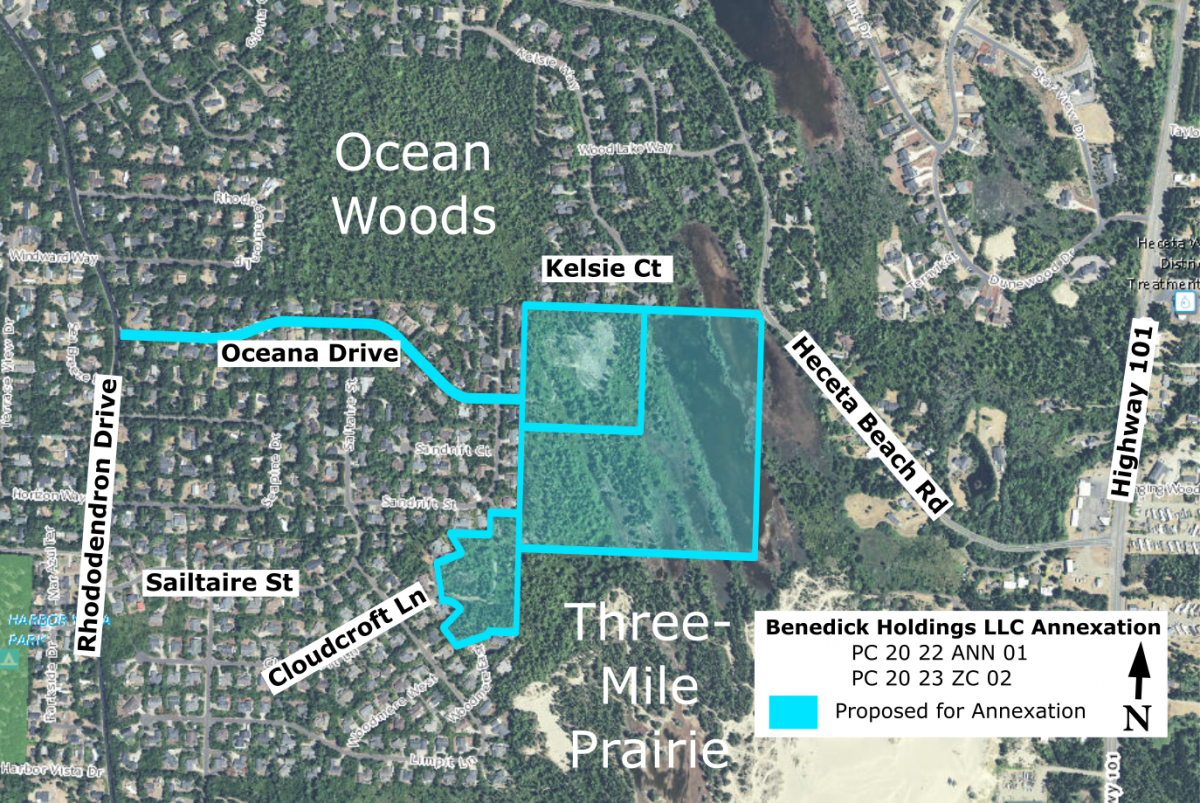-

-
Benedick Annexation and Surrounding Area Aerial Photo. Courtesy City of Florence.
In the fall of 2020, Florence began hearings on a proposal to annex some 48 acres of land owned by Benedick LLC into the city; the applicant described his ultimate goal as subdivision of the property into about thirty-two lots for housing. The proposal included annexing Oceana Drive, a local street. Currently the property is zoned Beaches and Dunes, but would be zoned Low Density Residential, with a Prime Wildlife overlay.
Under Oregon law, annexations are considered separately from later development proposals, and are usually not very controversial. But this application met with immediate, organized and vociferous opposition. The surrounding neighbors have experienced much seasonal flooding for many years, as well as increasing traffic congestion. The Benedick property is not prime subdivision land: it is a series of seasonal lakes, which reliably fill and flood every winter. The some 400 nearby homeowners felt, justifiably, that subdividing a series of seasonal lakes would greatly exacerbate the existing flood problems caused by earlier, poorly-designed, subdivision infrastructure that serves the existing houses. Stormwater management would be particularly important in any Benedick development on this parcel, because the property lies in a depression, or a large swale, comprised largely of wetlands. The land has a high water table and, being right on the coast, experiences consistent major yearly rainfall.
But despite the documented problems with seasonal flooding in the surrounding neighborhoods, and the seasonal lakes that come to life every winter on the Benedick property, the city of Florence held hearings through 2021, and approved the project, both at the planning commission and City Council. Testimony about Florence’s inadequate infrastructure to handle vast new amounts of stormwater, or even corral existing floods, fell on deaf ears.
The principal standard Florence had to meet here was its Annexation Policy 3, which requires “orderly, economic provision for public facilities and services.” That means the city had to consider if this annexation would provide orderly sewage, water, stormwater and transportation services. The answer in every instance is that it would not. A new sewer pumping station would be required, and houses in the right-of-way would be required to connect. The fate of those properties in the area using septic was never discussed at all.
Most outrageous of all in this proposal is that the annexation would (literally) pave the way for a subdivision development within seasonal lakes – rather than focusing on siting new development away from seasonal lakes, wetlands and other topographies that would exacerbate flooding. The South Heceta Junction Seasonal lakes are considered “significant wetlands” in the Florence area local inventory. Why did the city take no notice of that, when the city’s Wetlands and Riparian Objective #2 requires Florence to protect significant wetlands for their critical value in maintaining both surface and groundwater quality and quantity?
Since Florence approved this highly inappropriate annexation, Oregon Coast Alliance and neighbors appealed the decision to the Land Use Board of Appeals. Benedick argued that annexation determines nothing about future development, but it was the applicant’s own submissions that described their future development plans. Thus, ORCA and the neighbors felt that the annexation itself was sufficiently damaging to merit an appeal, given the city’s failure to follow its own requirements to protect the public health and safety by not placing areas for residential use in seasonal lakes, wetlands and areas of known and extensive annual flooding. If the court approves the city’s annexation, the neighbors and ORCA will begin the long process of wrestling with the details of a development application.
DOCUMENTS:
- ORCA to Florence City Council re Benedick Annexation February 2021
- Florence Final Order and Findings Approving Benedick Annexation April 2021
